Several species of native warm-season grasses have potential for biomass production, livestock forage and wildlife habitat in Missouri. Switchgrass is a popular choice because it produces large yields of dry matter — 3 to 6 tons per acre — over a wide range of conditions. There has also been interest in producing biomass and livestock forage using native warm-season grasses — switchgrass, indiangrass, big bluestem, little bluestem and eastern gamagrass — mixed with native forbs and legumes. Forbs are broadleaf flowering herbaceous plants; legumes are broad-leaved plants that often fix nitrogen. Legumes have a symbiotic bacteria called rhizobia within nodules in their root systems, producing nitrogen compounds that help plants grow.
This guide is a companion to MU Extension publication G9422, Integrating Practices That Benefit Wildlife With Crops Grown for Biomass in Missouri. The guide provides information to help landowners and property managers make informed decisions on enhancing wildlife habitats while producing crops for biomass. Information in that guide provides an overview of how plant composition — both within and around fields used for biomass production — affects wildlife habitat. It also describes management techniques that landowners and managers can use to benefit a diversity of wildlife species.
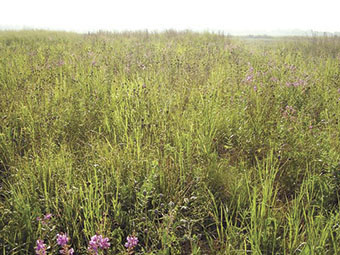
Figure 1
Forbs and legumes can be established with stands of native warm-season grasses to improve their value for wildlife and pollinator habitat.
This guide includes information on the use of these mixtures for the following benefits:
- Use of native warm-season forages — including grasses, forbs and legumes — for enhanced wildlife and pollinator habitat
- Use of these mixtures as a part of overall forage production objectives and increased haying and grazing opportunities
Additionally, MU Extension publication G9424, Using Native Warm-Season Grass, Forb and Legume Mixtures: A Case Study, details establishment, management practices and yield results from a three-year demonstration project studying these mixtures at the University of Missouri Bradford Research Center near Columbia, Mo.
Benefits of diverse stands of native forages
Enhanced wildlife and pollinator habitat
Fields with diverse vegetation typically attract a greater variety of wildlife than monoculture, or single species, stands of grass. For example, sod-forming grasses such as tall fescue tend to restrict movement for many species that need more open space for nesting and foraging. Lack of food is also an issue in monoculture stands of grasses, because they lack seed- and soft mast-producing forbs and shrubs.
Mixed stands of native warm-season grasses, which include forbs and legumes, provide food and cover required by wildlife such as grassland birds, bobwhite quail and cottontail rabbits. Diverse stands also provide excellent habitats for pollinators such as butterflies, bees and other insects (Figure 1). A selection of native forbs and legumes that can be established with native warm-season grasses can be found in Table 1. MU Extension publication G9422, Integrating Practices That Benefit Wildlife With Crops Grown for Biomass in Missouri, also provides more information on seeding rates for native grasses and forbs in Table 2.
Table 1
A selection of native forbs and legumes that can be established with native warm-season grasses.
| Forbs | Legumes |
|---|---|
| Ashy sunflower | Purple prairie clover |
| Maximillian sunflower | White prairie clover |
| Plains coreopsis | Roundhead lespedeza |
| Purple conflower | Slender lespedeza |
| Wild bergamot | Sensitive briar |
| Compass plant | Leadplant |
| Rosinweed | Tall Indigo |
| Rattlesnake master | Partridge pea |
| Tick trefoils | |
| Illinois bundleflower |
Table 2
Time of year for peak native warm-season and cool-season grass forage production levels.

Reduced fertility needs and greater organic matter storage
Native warm-season grasses have adapted to an environment with relatively low soil nutrients; with some exceptions, they are not particularly responsive to nitrogen fertilizers. These grasses are very efficient users of nitrogen when it is applied for increased hay production when it is needed. Be sure to take a soil test to determine current fertility levels and recommended fertilizer application rates.
Mixtures of native warm-season grasses and forbs can store an abundance of organic matter and hold more soil carbon than monocultures of cool-season grasses. These mixtures contain two-and-a-half to three times more biomass in their root systems than in above-ground growth, and they replace more than 30 percent of their root system each year (Figure 2). Legumes are an important part of these systems, too, because symbiotic bacteria on their root systems have the ability to fix nitrogen from the atmosphere, thus providing nitrogen necessary for growth in a stand of grasses.
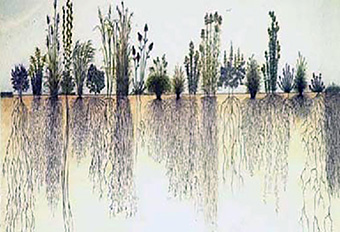
Figure 2
Native grass, forb and legume mixtures help maintain soil health, improve soil organic matter and prevent nutrients from infiltrating adjacent streams. Note the soil depth comparison of the root system of Kentucky bluegrass on the far left with the root systems of a variety of native forbs and warm-season grasses. Image used courtesy of the Conservation Research Institute and Heidi Natura.
Greater drought tolerance
Stands of native warm-season forages tolerate drought better than cool-season grasses (Figure 3). Their larger root systems and more efficient photosynthetic capacity allow them to flourish in high temperatures and drought conditions typical in summer. Native warm-season grasses such as switchgrass, big bluestem and indiangrass produce root systems that often reach 10 feet deep if bedrock is not limiting. For example, switchgrass can produce about four times as much root biomass as cool-season grasses, such as tall fescue, in the first year after planting.

Figure 3
The stand of native warm-season grasses and forbs on the left is more likely to survive drought conditions and still produce forage. The field of tall fescue on the right is dormant and does not provide grazing or hay crops during prolonged periods of dry conditions in the summer.
Haying and grazing opportunities
Native warm-season forages that include grasses, forbs and legumes can also be used for hay and grazing (Figure 4). As shown in Table 2, native warm-season grass forage production peaks during the warmer months of June, July and August compared with cool-season grasses that produce more forage earlier in the growing season. Native grasses can produce excellent quality hay and provide grazing; however, as with other forage grasses, their quality and yield depends on maturity.
For haying, the timing of cutting is important when harvesting native stands. The times for maximum tonnage and highest quality forage occur at different times of the year. Maximum tonnage typically occurs in July and August, whereas the highest quality forage typically occurs earlier, depending on the species. For instance, the crude protein of most native warm-season grasses is typically 15 percent at the beginning of the growing season but declines to 4 or 5 percent in August as the plants mature.
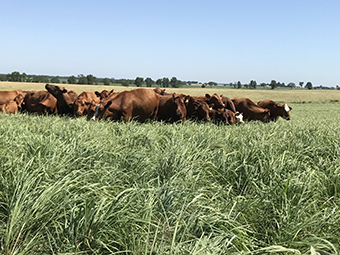
Figure 4
Stands of native warm-season grasses, forbs and legumes can be used for hay or grazing, providing a summer forage for livestock.
Native warm-season grasses can provide high-quality forage when harvested at proper times, but they tend to be high in fiber and low in protein compared to forbs and legumes. Mixing forbs and legumes with native grasses can increase forage quality and prolong the window of time when these mixtures can be used, thus maximizing their forage value.
Research has shown that livestock gain well when grazing native warm-season forages during summer months, with steers posting gains of between 11/2 and 2 pounds per day. Mixtures of big bluestem, little bluestem, indiangrass, and eastern gamagrass are more commonly established than monoculture plantings. Switchgrass is generally not recommended in mixtures because it matures more rapidly than these other grasses and makes stands more difficult to manage.
Haying and grazing considerations that affect wildlife
Native warm-season grasses, forbs and legumes can provide forage for livestock, as well as sources of food and cover for wildlife. However, the value of these mixtures for forage or for wildlife habitat varies greatly depending on how they are managed. These plant mixtures can either be harvested as a hay crop or grazed in the field. Landowners and managers need to consider several management strategies, such as those described below, to be most successful.
Haying considerations affecting wildlife
Mixtures of these native forages should be harvested at the appropriate time for the best quality hay. Balance forage quality and yield by haying grasses while, or just before, they flower. Switchgrass and eastern gamagrass are usually the first to mature and begin flowering in mid-May. Big bluestem and indiangrass develop later, usually in June.
The timing of cutting these mixtures for hay has implications for wildlife, especially ground-nesting songbirds (Table 3). Grassland songbirds tend to nest in stands of native grass no taller than 36 inches. Species such as eastern meadowlarks, grasshopper sparrows, Henslow's sparrows and dickcissels are migratory, so they return to Missouri to nest in April. First nesting attempts begin in May, and these birds generally need 23 days of nesting for young to fledge and leave the nest. Grassland songbirds typically need at least a six-week window in which to establish a nest, lay and incubate eggs, and rear young. Therefore, harvesting hay before mid-June can be harmful to migratory bird nesting. Although grassland songbirds might nest two or three times in spring and summer, the initial nesting attempt is the most important for sustaining populations.
Table 3
Approximate nesting times for bobwhite quail and selected species of grassland birds in Missouri with times of year with maximum yield and quality for various cool-season and warm-season forages in Missouri.
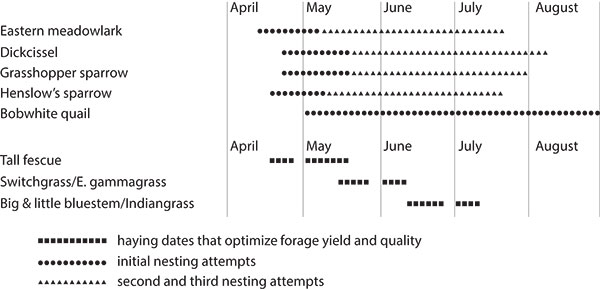
Bobwhite quail begin nesting in grassland habitats from late April through May (Figure 5). The peak hatch for these first nests is typically in mid-June. Bobwhite hens often attempt to nest again and lay a second clutch of eggs that hatch in mid-August. Haying at any time from late April through mid-August can negatively impact bobwhite nesting success.
However, harvesting native warm-season grass fields can provide adequate brood cover for bobwhite chicks, particularly if forbs and legumes such as ragweed, clover and partridge pea are present. Haying tends to remove dense vegetation at ground level which improves access for quail chicks to use these areas for food and cover. Thus, harvesting native warm-season grasses and mixtures in June or July can produce adequate yields and still provide some limited wildlife benefits, particularly if only a portion of the field is harvested. Cutting height should be no lower than 6 to 8 inches to facilitate regrowth and maintenance of overhead cover.

Figure 5
Bobwhite quail nesting activity begins in late April and can continue through July. Peak hatching of the first clutch of eggs will usually occur in mid-June.
The primary period for nesting and brood rearing for bobwhite quail is June through August, whereas grassland songbirds have typically finished nesting and brood-rearing by mid-August. Therefore, avoid haying in August if these species are a consideration. Hay quality is poor at this time of year and grass regrowth is often insufficient to provide winter cover for resident species such as bobwhite quail and wintering sparrows.
Grazing considerations affecting wildlife
For most wildlife, including grassland songbirds, grazing these mixtures at light to moderate stocking rates during the growing season (late spring and early summer) is often preferable to high-intensity, short-rotation grazing. This grazing strategy also benefits bobwhite quail because it creates an open structure at ground level, which facilitates wildlife movement and feeding and maintains a canopy of overhead cover. This open ground structure also benefits most grassland songbirds. Season-long grazing with livestock numbers that are required to maintain a 14- to 36-inch forage canopy height typically does not disturb nesting. Forbs and legumes improve not only livestock forage but also food availability for wildlife.
Alternatively, allowing livestock to graze for a short time during early spring, then moving animals in June to allow for regrowth works well. You can put various rotational grazing systems in place to achieve these goals, depending on your stocking and forage management objectives.
You can also implement a complementary grazing system that benefits wildlife and forage production. In this system, livestock graze cool-season grasses and legumes in the early spring, native warm-season grasses and forbs in the late spring and early summer and cool-season grasses and legumes again in the late summer and fall. About one-third of the pasture acreage should be in native warm-season forages if this system is used.
The University of Missouri works with the United States Department of Agriculture's Natural Resources Conservation Service (NRCS) to offer technical assistance for rotational grazing plans. Financial assistance also is available for establishing native grasses and grazing systems that address forage production and wildlife habitat. MU Extension and the NRCS also collaborate on conducting MU Grazing Schools throughout the state. Contact your local MU Extension Center or the NRCS for more information.
Benefits of delaying the harvest for wildlife
Native warm-season grasses produced for biomass are typically harvested only once annually in fall or winter after a killing frost when mineral and moisture contents are lowest. Nesting wildlife benefit from fall or winter harvests that allow time for protective cover to regrow for use in spring and summer. You can also delay harvest until late winter or early spring or harvest small sections of a field and leave other areas unharvested to provide wildlife with protection from predators and extreme weather conditions in the winter. Harvesting biomass in late October or November destroys winter cover, but delaying harvest to later in the winter or early spring affords migrating and overwintering birds and other wildlife with protective cover during this time of year. Any loss in yield when delaying harvest until the following spring will be minimal unless heavy snowpack causes grasses to lay over near ground level, making harvest more difficult.
Prescribed fire as a management tool to increase plant diversity
Stands of native warm-season grasses and forbs need periodic prescribed fires as shown to maintain optimum conditions for forage production, as well as to provide benefits for wildlife (Figure 6). Conducting a prescribed burn is an excellent management tool for increasing plant diversity and improving the forb component of a stand of grass. Fire removes accumulated dead plant litter and creates more open conditions at ground level that encourage the germination of these important food plants. The season, or timing, and frequency, or burn interval, of a prescribed fire is crucial to achieving success and to maintain plant diversity within the stand.
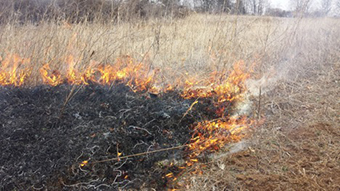
Figure 6
Periodic prescribed fires benefit forage production and wildlife.
To encourage growth of native warm-season grasses, conduct a prescribed burn late in the dormant season — usually late March and early to mid-April — to stimulate grass growth and improve forage quality. To encourage growth of forbs and legumes, conduct prescribed burns in late summer, fall or winter. Conducting a prescribed fire every three years reinvigorates stands of warm-season grasses, encourages growth of native forbs and legumes, helps control the spread of undesirable cool-season grasses such as tall fescue and controls woody vegetation and sprouts. It is best to burn only about a third of a field each year, leaving the previous years' growth in place for nesting habitat for a variety of species such as bobwhite quail, eastern meadowlarks, grasshopper sparrows and cottontail rabbits. Contact a natural resource professional with the Missouri Department of Conservation (MDC) or the NRCS for technical assistance and information before conducting a prescribed fire. Refer to publications in the Additional Resources section for guidance on planning and conducting prescribed burns.
Summary
Native warm-season grasses, forbs and legumes can provide high-quality forage, biomass and improved wildlife habitat and use of these mixtures can complement grazing systems with existing cool-season forages such as tall fescue. These stands can be harvested during the summer months at the appropriate stage of maturity and can provide a source of forage and other benefits should drought conditions occur. In addition, the use of native warm-season forages typically require less fertilizer and lime to sustain their productivity.
If improved wildlife habitat is an important goal then trade-offs will need to be taken into consideration. Frequent harvests for hay and long-duration grazing that leaves grass heights at low levels should not be conducted if wildlife are a consideration. The timing of implementing various management practices, such as grazing and haying are particularly important. Regardless of the grass species that is established (big and little bluestem, indiangrass, switchgrass, and eastern gamagrass), moderate season-long grazing can provide excellent habitat for grassland songbirds, bobwhite quail and cottontail rabbits, particularly if forbs and legumes are included in the mixture and appropriate management practices are conducted on a timely basis.
For more information contact your MU Extension Center. The Missouri Department of Conservation (MDC) and NRCS also provide technical assistance for establishing mixtures of native warm-season forages on your property.
Resources
- Missouri Department of Conservation, Country land care packet
- Missouri Grow Native Program
- Missouri Native Seed Association
- United States Department of Agriculture, Natural Resources Conservation Service (USDA-NRCS)
- Conservation practice information sheet: Native forb information sheet: Establishing native forbs
- United States Department of Agriculture, Natural Resources Conservation Service Job Sheet, Native forb and non-native legume interseeding
- United States Department of Agriculture, Natural Resources Conservation Service Plant Materials Program, Elsberry Plant Materials Center, Serving areas in the States of Illinois, Iowa and Missouri
References
- Fargione, J.E., T.R. Cooper, D.J. Flaspohler, J. Hill, C. Lehman, T. McCoy, S. Mcleod, E.J. Nelson, K.S. Oberhauser, and D. Tilman. 2009. "Bionenergy and wildlife: threats and opportunities for grassland conservation." Bioscience 59 (9): 767–777.
- Harper, C.A., and P.D. Keyser. 2008. SP704-A-Potential impacts on wildlife of switchgrass grown for biofuels. (SP704-A). University of Tennessee Extension.
- Harper, C.A., E.D. Holcomb, P.D. Keyser, J.L. Birckhead, J.C. Waller, and G.E. Bates. 2013. Wildlife considerations when haying or grazing native warm-season grasses. (SP731-H).University of Tennessee Extension: 7.
- Keyser, P., G. Bates, J. Waller, C. Harper, and E.D. Holcomb. 2012. Grazing native warm-season grasses in the mid-South. (SP731-C). University of Tennessee Extension.
- Keyser, P., G. Bates, J. Waller, C. Harper, F. Allen, and E.D. Holcomb. 2012. Producing hay from native warm-season grasses in the mid-South. (SP731-D). University of Tennessee Extension.
- Rupp, S.P., L. Bies, A. Glaser, C. Kowaleski, T. McCoy, T. Rentz, S. Riffell, J.Sibbing, J. Verschuyl, and T. Wigley. 2012. Effects of Bioenergy Production on Wildlife and Wildlife Habitat. Technical Review 12-03. Bethesda, MD: Wildlife Society.
- Tilman, D., J. Hill, and C. Lehman. 2006. "Carbon-Negative Biofuels From Low-Input High Diversity Grassland Biomass." Science 314: 1598-1600.
Photo and illustration credits: Conservation Research Institute, Heidi Natura; Missouri Department of Conservation; Ryan Lock; Robert Pierce II; Ray Wright